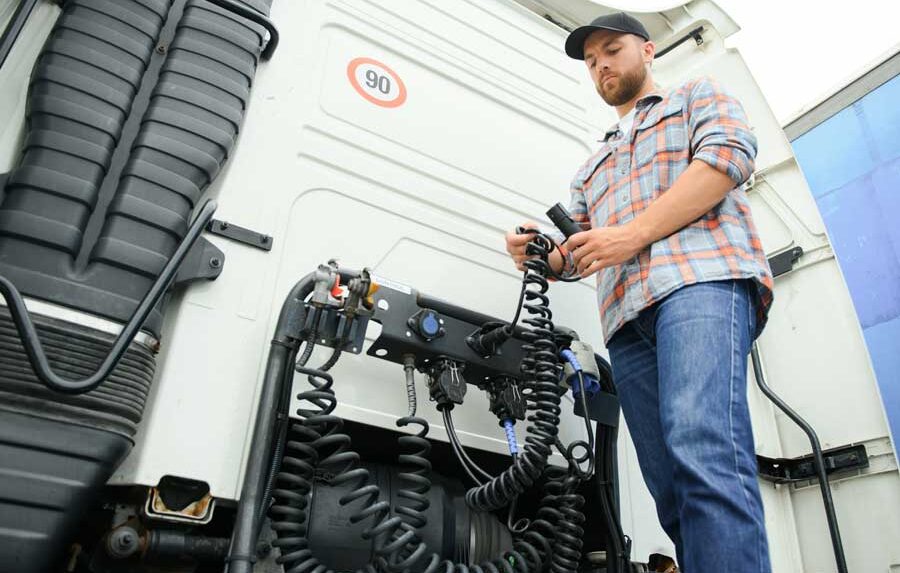Key Takeaways:
- Telematics devices and Event Data Recorders (EDRs) are common in modern vehicles, with telematics transmitting ongoing data and EDRs recording information during significant events like accidents.
- Telematics devices are typically compact and installed in locations such as the OBD-II port or the telematics control unit, while EDRs are often housed in the vehicle’s central electronics unit.
- Telematics devices vary in appearance but are often small, rectangular or square, and may have connectors or antennas for data transmission and communication.
- Understanding the location and function of telematics devices is important for vehicle owners and fleet managers to utilize the technology effectively for vehicle management, safety, and data retrieval.
- While telematics systems offer benefits like navigation, safety features, and usage-based insurance, privacy concerns regarding data collection and usage should be considered.
Table of Contents
Maximize Vehicle Safety and Efficiency by Locating the Black Box in Your Car
Many vehicle owners wonder about the mysterious black box in their car. Commonly associated with aviation, the term refers to devices that record critical data within vehicles. Telematics devices and Event Data Recorders (EDRs) are the most prominent examples. According to a 2020 report, 96% of vehicles in the U.S. are equipped with some form of telematics device, which helps track vital data, such as speed, braking force, and vehicle diagnostics. These devices collect real-time information, improving fleet management and safety.
The term black box often refers to a singular device and it encompasses multiple technologies with different functions. Telematics devices transmit ongoing data related to vehicle performance, such as fuel efficiency and engine diagnostics. Event Data Recorders (EDRs) on the other hand focus on taking information during significant events, like accidents. Studies show that EDRs are present in over 50% of vehicles manufactured since 2014, with the ability to get important information, such as crash speed and seatbelt usage. This data has a vital role in accident investigations, helping to clarify the circumstances surrounding a crash.
Understanding the location and function of the black box in car can help vehicle owners and fleet managers better utilize these devices. Typically, telematics devices are integrated into the vehicle’s onboard diagnostic port or the telematics control unit. EDRs, on the other hand, are usually housed in the vehicle’s central electronics unit. Identifying these devices guarantees car owners and fleet operators can manage their vehicles’ data accurately, improving operational efficiency and safety.

Examine Common Telematics Device Connectors
A telematics device is compact, often no larger than a smartphone, designed for easy integration into a vehicle’s system. The device size and shape vary depending on its intended use, but these devices are typically small and unobtrusive. Most are designed to be easily installed, whether in a fleet vehicle or a personal car, without disrupting the vehicle’s operation or aesthetic.
Telematics devices usually have a rectangular or square form, with most models fitting comfortably into a vehicle’s onboard diagnostic (OBD) port, often located beneath the dashboard near the steering wheel. These devices often measure between 2 to 6 inches in length and about 1 to 2 inches in width, making them portable and efficient for their purpose. They are often lightweight, typically weighing no more than a few ounces, which aids in their smooth installation in vehicles of all sizes.
Identifying these devices visually involves looking for specific markings or labels. The device will often have the manufacturer’s logo or name on one side, usually printed in small text. In some cases, a distinct serial number or identification code is also included for tracking and inventory purposes. Connectors or ports may be visible, especially in more advanced systems.
These connectors can be used to plug in external sensors or power sources, depending on the device’s function. Some devices are designed to connect wirelessly to the vehicle’s telematics system, while others use wired connections, especially in commercial or fleet vehicles. These external connectors may help you distinguish a telematics device from other vehicle components.
While the general appearance of a telematics device remains similar, variations exist based on the manufacturer and the device’s functionality. A basic model may appear as a simple plug-in unit, which fits into the OBD-II port and communicates basic diagnostic data. More advanced models might look slightly more complex, incorporating additional ports, antennas, or even small displays.
These versions are designed for more sophisticated uses, such as GPS tracking, real-time diagnostics, or integration with fleet management systems. Some devices may even come with small screens to display vehicle data, such as fuel efficiency or maintenance alerts.
Despite the general consistency in size, the appearance of telematics devices can vary greatly depending on their functionality. Some devices may have integrated GPS antennas for tracking vehicle location, while others might have sensors for monitoring the engine’s performance or tire pressure.
In addition, these devices may include wireless communication modules like Bluetooth or Wi-Fi, which could alter their appearance slightly, making them look more intricate. Larger systems installed in fleet vehicles could involve separate components that are mounted in different areas of the vehicle, including under the dashboard, in the trunk, or near the vehicle’s power source. These devices are often designed with multiple connectors, which allow for a range of data collection points.
The primary function of telematics devices is to collect, store, and transmit data about a vehicle’s performance. the device gathers information such as the vehicle’s speed, fuel Telematics Devices collect data such as fuel consumption, tire pressure, engine diagnostics, and location based on the device’s setup.
Fleet operators benefit from this data by receiving real-time updates on vehicle performance and location. Personal vehicles gain insights into driving habits, maintenance alerts, and location tracking for theft recovery. The data transmitted by the device can be used for various purposes, such as remote diagnostics, driver behavior monitoring, and even insurance tracking for usage-based insurance programs.
Understanding what a telematics device looks like and how to identify it is important for anyone looking to make the most of this technology. These devices can range from simple plug-in units to complex systems integrated into the vehicle’s electronics.
Recognizing the device size and shape and being able to spot connectors and identifying features can help vehicle owners and fleet managers determine which device they are dealing with. As vehicle technology continues to advance, telematics devices will only become more specialized, contributing to improved vehicle management, safety, and performance.
Common Installation Locations of Telematics Devices
Telematics device location within a vehicle is typically chosen based on ease of installation, connection, and the type of data the device needs to collect. The most common placement is the OBD-II port, typically located under the dashboard near the driver’s side, often near the steering column.
This port is easily accessible and allows the device to interface with the vehicle’s onboard computer system. The OBD-II port provides a direct link to the vehicle’s engine control unit (ECU), allowing the telematics device to monitor critical performance metrics such as engine diagnostics, speed, fuel consumption, and more.
For more advanced telematics systems, the installation may extend to other locations within the vehicle. In some cases, telematics devices are installed in the trunk or near the vehicle’s power source, especially for fleet vehicles requiring additional data collection points, such as battery health or fuel levels. In these setups, the device may be connected to sensors and additional wiring to gather more specific information about the vehicle’s systems.
Accessibility factors have a key part in deciding telematics device location. Devices need to be easily accessible for installation, maintenance, and troubleshooting. The OBD-II port is preferred due to its standardized location across most vehicles, which guarantees that technicians can easily access the device for diagnostics or updates. In some cases, telematics devices are installed in locations that require minimal tools for maintenance, guaranteeing that the vehicle’s operation is not disrupted during servicing.
Security considerations are significant when deciding on telematics device location. The installation site must be discreet and secure to prevent tampering or theft. For instance, placing the device under the dashboard or inside the vehicle’s central electronics unit minimizes the risk of unauthorized access.
Some fleet vehicles may install additional security features, such as tamper detection or anti-theft measures, to prevent the removal or manipulation of the telematics Device. Guaranteeing a secure installation not only protects the device but also guarantees the integrity of the data it collects.

Where is the Black Box in a Car Typically Located?
A black box in a car, more commonly known as a telematics device, is often positioned in various locations within a vehicle. The placement of the device depends on its purpose, functionality, and the vehicle’s design.
These devices collect important data for vehicle diagnostics, safety monitoring, and tracking. They must be installed in locations that allow easy access, security, and efficient data collection. This article explores common locations where these devices are typically installed and explains why these areas are favored for telematics device location.
Under the Dashboard
One of the most common locations for a black box in a car is under the dashboard. This area is easily accessible and provides a stable mounting point for the device. Under the dashboard, near the steering column, is the OBD-II port, a standard location where many Telematics Devices are plugged in.
The OBD-II port serves as the primary interface between the telematics device and the vehicle’s onboard computer system, giving it direct access to the engine control unit (ECU) and other critical systems. This location is often favored because of its central position, allowing the device to gather a wide range of vehicle data, including speed, fuel consumption, engine diagnostics, and more.
Mounting a telematics device under the dashboard guarantees that the device is hidden from plain view while still being within reach for installation or servicing. The area provides a secure and protected environment for the device, preventing tampering or exposure to environmental factors such as moisture or extreme temperatures. The wires or connectors for the device can also be concealed behind the dashboard components to maintain the vehicle’s aesthetic and avoid interference with other internal systems.
Behind the Glove Compartment
Another common telematics device location is behind the glove compartment. This area is accessible and often used for installing devices that require a slightly more hidden position. The glove compartment provides a protected space for the device, making it difficult for anyone to notice or tamper with it.
The device can then be mounted securely within the space. This location is favored for its security, as it is not easily visible from the outside of the vehicle. However, it is still accessible enough for maintenance or troubleshooting when necessary.
For advanced telematics devices used in fleet vehicles or high-end models, the area behind the glove compartment can also accommodate more helpful equipment, such as GPS tracking modules or additional sensors. These devices often require more space than the typical black box used in personal vehicles, making the glove compartment a viable location for installation.
Near the OBD-II Port
The OBD-II port, which is typically located near the driver’s side of the vehicle, is one of the most common locations for a black box in a car. This port is designed to provide access to the vehicle’s electronic systems, allowing diagnostic tools and telematics devices to communicate directly with the vehicle’s onboard computer system.
The OBD-II port is a standard feature in most modern vehicles, making it an ideal spot for installing a telematics device. A telematics device installed here can easily access data related to engine performance, fuel efficiency, speed, and other important metrics. The OBD-II port is located under the dashboard near the steering column, and many devices simply plug directly into this port. Some telematics devices may use the port for communication and power, while others might be connected to additional sensors or equipment mounted elsewhere in the vehicle.
Telematics devices may use the OBD-II port as the central hub for gathering data. From here, the device can collect and transmit information from multiple sensors located throughout the vehicle. The advantage of this location is that it offers direct access to critical data without the need for complicated installations or additional wiring. For fleet vehicles or cars equipped with advanced telematics systems, additional modules may be installed around the vehicle to complement the telematics device in the OBD-II port.
In the Center Console
Another location where telematics devices can be found is within the center console of the vehicle. The center console typically contains a variety of features such as cup holders, storage compartments, and sometimes even the car’s infotainment system. This area can serve as an effective mounting point for telematics devices, particularly if the vehicle is equipped with a system that requires more space or specialized installation.
The center console location is often used for devices that require more connections, such as those with Bluetooth, Wi-Fi, or cellular communication capabilities. Devices installed in this area may also be part of an advanced infotainment or navigation system, which integrates vehicle data with user interfaces. The center console provides a convenient spot for these devices, allowing easy access for vehicle owners and technicians while keeping the installation discreet.
One advantage of using the center console for device placement is that it allows for easy access to other vehicle systems. For example, a telematics device connected to the infotainment system can directly access the vehicle’s GPS, audio controls, and other integrated features. This integration allows for improved functionality, enabling the telematics device to offer features such as real-time location tracking, driving behavior monitoring, and even remote diagnostics.
Under the Seats
Telematics devices can also be installed under the seats of a vehicle. This location is generally used for more advanced systems, particularly in larger vehicles such as trucks or fleet cars. Mounting a telematics device under the seat offers a discreet location, preventing tampering or unauthorized access to the device. It also keeps the device hidden from view, reducing the likelihood of theft or interference.
Installing the device under the seat may require specialized mounting brackets or supports, as the area is not typically designed for easy access to electronics. However, for fleet vehicles, this location is often preferred because it allows for easier concealment and security. In addition to standard telematics devices, the space under the seats may also be used for additional sensors or equipment related to vehicle tracking, diagnostics, or security systems.
Although less common in personal vehicles, installing telematics devices under the seats can be advantageous for vehicles that require extra data collection points, such as those used for fleet management or monitoring of cargo.

A Step-by-Step Guide on How to Find the Black Box in a Car
Gather Tools
Before beginning your search for the black box in a car, gather the necessary tools for inspection. A flashlight is essential for inspecting dark areas under the dashboard or seats. A small screwdriver may be required to remove panels if needed. It is also helpful to have a mirror on a stick to see hard-to-reach areas.
Visual Inspection
Start with a visual inspection of the car’s interior. Look under the dashboard and near the glove compartment, as these are common areas for telematics device location. Keep in mind that these devices are usually small and compact, so they may blend in with the vehicle’s existing components. If you have access to the OBD-II port, check there as well, as it may house a device connected to the vehicle’s diagnostic system.
OBD-II Port Check
The OBD-II port is a key location for many telematics devices. It is typically located beneath the dashboard, near the driver’s seat. Look for a rectangular port that is about 2 inches in length. Many devices are plugged into this port, so checking here can give you a good starting point. It’s possible that the black box or related devices are linked to the vehicle’s electronic control units through this port.
Panel Removal
If you cannot locate the device through visual inspection alone, panel removal might be necessary. Use the screwdriver to carefully remove dashboard panels or trim around the glove compartment, under the steering wheel, or near the center console. Be cautious not to damage any wires or components while removing these panels. Devices may be mounted behind these panels, so proceed carefully and follow the vehicle’s manual for guidance on panel removal.
Cautionary Notes
Search carefully when locating the black box in car systems. Avoid rushing or applying pressure when checking behind panels or under components. Telematics device units are often secured tightly and can be damaged by force. Follow basic safety steps when working inside the vehicle.
Event Data Recorders (EDRs) vs. Telematics Devices
Event Data Recorder (EDR)
An Event Data Recorder (EDR) is a device installed in vehicles to record data related to vehicle performance and crash events. It takes critical information during a crash, such as speed, braking, seatbelt use, airbag deployment, and other safety-related metrics. This data is retrievable after a crash and helps in accident investigations, providing insight into the events that led up to the accident.
EDR Appearance and Location
The appearance of an EDR varies depending on the vehicle manufacturer but is generally compact and discreet. It is often installed behind the glove compartment, under the dashboard, or near the OBD-II port, and is integrated into the vehicle’s computer system. EDRs are designed to be inconspicuous, as they are meant to take data without affecting the driver’s experience.
Telematics Device
A telematics device is used for continuous monitoring of vehicle data, including speed, fuel consumption, tire pressure, and location. It is typically installed in various locations such as the OBD-II port, under the dashboard, or within the center console. These devices offer real-time updates on vehicle performance, making them useful for fleet management, driver behavior monitoring, and insurance tracking. Unlike EDRs, which only activate during critical events, telematics devices constantly collect and transmit data.
Differences in Data
The data detected by an Event Data Recorder (EDR) differs from that recorded by telematics devices. EDRs focus on crash-related data, such as vehicle speed, braking patterns, and airbag deployment, which helps in accident reconstruction. In contrast, telematics devices record data related to the vehicle’s ongoing performance, including fuel efficiency, tire pressure, and real-time location, offering a broader view of vehicle operations.
Vehicle Data Recorder
A vehicle data recorder is a general term that can refer to any device installed in a vehicle that records data related to its operation. This includes both EDRs and telematics devices, which track different sets of data. The vehicle data recorder can detect information from both systems depending on the type of device installed in the vehicle. These devices are essential in fleet management, offering insights into vehicle performance and driver behavior.

The Role of Telematics in Modern Vehicles
The rise of factory-installed telematics devices in modern vehicles marks a significant shift in automotive technology. Many new vehicles now come equipped with telematics systems as part of their standard features. These systems provide a range of functionalities, from navigation and safety features to more advanced capabilities like real-time diagnostics.
Factory-installed telematics systems are designed to be integrated smoothly into the vehicle, offering convenience and improved user experiences. As the automotive industry continues to evolve, more manufacturers are including these systems in their vehicles, making them a standard feature across many vehicle models.
Data Usage and Applications
The data collected by telematics devices serves various applications that benefit both drivers and fleet operators. One of the primary uses is in management, where telematics systems can offer real-time traffic updates and provide the best routes based on current conditions. Additionally, telematics data have an important role in safety features such as emergency response services, collision alerts, and tracking vehicle health through diagnostics.
For individuals, telematics devices are often linked with usage-based insurance, where driving habits, such as speed and braking patterns, influence insurance premiums. This data-driven approach allows for more personalized and accurate pricing. Telematics device location is critical in enabling accurate tracking and monitoring of a vehicle’s performance and status.
Connectivity and Integration
One of the standout features of modern telematics systems is their ability to connect smoothly with other vehicle systems and external networks. Telematics devices are integrated with various onboard systems, such as the engine control unit (ECU) and tire pressure monitoring systems, to provide real-time insights into the vehicle’s condition. They can communicate with cloud-based platforms, allowing drivers to monitor their vehicles remotely, receive alerts, and even manage settings through mobile apps.
Device size and shape contribute to their discreet installation, often being housed in small, compact enclosures that fit neatly into available spaces, such as behind the dashboard or near the OBD-II port. This integration between internal and external networks guarantees the vehicle is constantly connected, allowing for continuous data transmission and immediate access to critical information.
Common Installation Spots and Identifying Features
The common installation spots for telematics devices are typically areas that offer easy access to vehicle systems, such as the OBD-II port, under the dashboard, or near the glove compartment. These locations allow for easy installation and maintenance while makign sure that the device remains unobtrusive. The identifying features of these devices can vary, but many are small, black boxes with minimal markings.
They may also feature connectors for data cables or antennas that facilitate communication with external networks. Identifying these devices requires attention to detail, as their device size and shape often mimic other vehicle components, making them difficult to distinguish without closer inspection.

Understanding Telematics Devices and Their Location
Understanding the appearance and telematics device location of a Black Box in Car is important for both personal and fleet vehicle owners. Their device size and shape typically allows for discreet installation, making them easy to overlook. Recognizing where these devices are located can help in situations where data retrieval or device maintenance is necessary.
Privacy concerns surrounding telematics devices are important to consider as they collect a variety of data, including vehicle location, speed, and driver behavior. Drivers should be aware of the information these devices track and take steps to guarantee their privacy is respected. Transparency from manufacturers and service providers regarding data usage is essential for peace of mind.
Need assistance locating the Black Box in Car or understanding how these devices work? Geosavi offers expert services in GPS tracking and telematics. Our team helps you identify, understand, and manage your vehicle’s telematics system. Contact Geosavi for more information and professional guidance to optimize your vehicle’s data tracking and privacy.